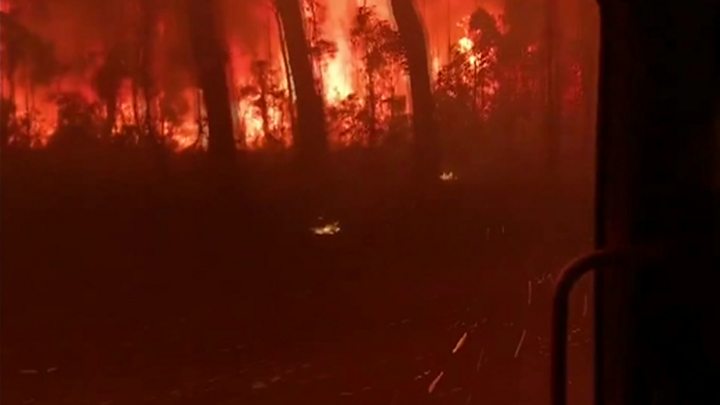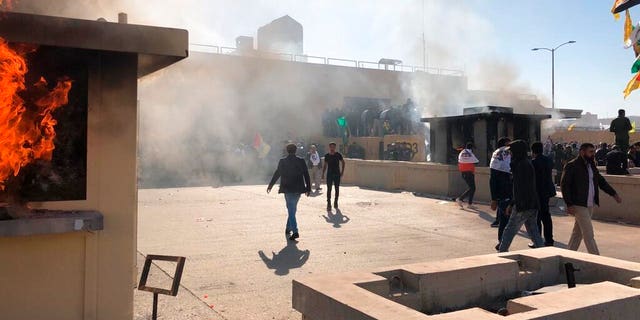Supporters of an Iranian-backed militia besieged the U.S. Embassy in Baghdad on Tuesday in retaliation for U.S. airstrikes, breaking into the embassy compound and damaging a reception area before being expelled by Iraqi security forces.
●U.S. diplomats took refuge in a safe room as guards fired tear gas at the invading protesters and tried to put out fires they set.
●President Trump accused Iran of “orchestrating an attack” on the embassy.
●Iraqi security forces later intervened and set up a barricade, but protesters threw gasoline bombs into the compound.
●The Kataib Hezbollah militia vowed to force the embassy to shut down.
BAGHDAD — Hundreds of angry supporters of an Iranian-backed militia shouting “Death to America” broke into the U.S. Embassy compound in Baghdad on Tuesday, trapping diplomats inside in response to U.S. airstrikes that killed or wounded scores of militia fighters.
Tensions eased somewhat later in the day after Iraqi security forces intervened, erecting a steel barrier at the smashed gate into the compound’s reception area and forcing the protesters to leave. However, protesters outside periodically threw molotov cocktails into the compound and tried to tear down the razor wire atop its walls, as guards inside fired stun grenades at them.
President Trump responded angrily Tuesday to the protesters’ actions, charging that Iran was behind a deadly militia attack that led to the airstrikes and blaming Tehran for the embassy siege.
“Iran killed an American contractor, wounding many,” Trump tweeted from his Mar-a-Lago estate in Florida. “We strongly responded, and always will. Now Iran is orchestrating an attack on the U.S. Embassy in Iraq. They will be held fully responsible. In addition, we expect Iraq to use its forces to protect the Embassy, and so notified!”
He added later in a separate tweet: “To those many millions of people in Iraq who want freedom and who don’t want to be dominated and controlled by Iran, this is your time!”
A spokesman for the Kataib Hezbollah militia said the demonstrators intend to besiege the embassy until the facility shuts down and U.S. diplomats leave Iraq.
Thaier al-Sudani
Reuters
Hashd al-Shaabi fighters set fire on the U.S. Embassy wall in Baghdad on Tuesday.
But the angry demonstrators defied appeals delivered over loudspeakers by the group’s leaders not to enter the embassy compound and smashed their way into one of the facility’s reception areas, breaking down fortified doors and bulletproof glass and setting fire to the room.
American guards inside the embassy fired tear gas to keep the militia supporters at bay. U.S. troops could be seen nearby and on rooftops, their weapons drawn, but they did not open fire. Embassy civil defense workers just inside the gates attempted to put out the fires with water hoses.
The protesters also smashed security cameras, set two guardrooms ablaze and burned tires. They made a bonfire out of a pile of papers and military MREs (meals ready to eat) found in the reception area, where guards normally search visitors. Kataib Hezbollah flags were draped over the razor wire protecting the embassy’s high walls.
The embassy’s sirens wailed continually as dense black smoke billowed into the air.
Inside the embassy, U.S. diplomats and embassy staffers were huddled in a fortified safe room, according to two reached by a messaging app. They declined to give details but added that they felt secure.
Protesters stormed the U.S. embassy in Baghdad on Dec. 31, setting fires and destroying security cameras, after U.S. carried out airstrikes on Dec. 29 against an Iranian-backed militia. (Editor’s note: This video has no sound.)
By early afternoon, tensions had eased somewhat after an Iraqi army commander showed up and ordered Iraqi security forces, who had initially made no attempt to intervene, to prevent the demonstrators going farther inside the facility. The security forces formed an impromptu buffer between the demonstrators and the American guards inside.
Shortly after that, acting Iraqi prime minister Adel Abdul Mahdi appealed for calm and urged the demonstrators to refrain from entering the compound. He said in a statement that it is the government’s responsibility to protect foreign embassies.
In Washington, Secretary of State Mike Pompeo spoke to Abdul Mahdi and Iraqi President Barham Salih separately by phone Tuesday and “made clear the United States will protect and defend its people, who are there to support a sovereign and independent Iraq,” department spokeswoman Morgan Ortagus said. “Both Abdul Mahdi and Salih assured the secretary that they took seriously their responsibility for, and would guarantee the safety and security of, U.S. personnel and property,” she said.
The embassy compound lies inside the heavily fortified Green Zone, which is normally off limits to ordinary people. But earlier in the morning, thousands of people walked unimpeded into the zone to join the demonstrations, as many Iraqi security forces simply mingled with the crowd.
Their chants of “Death to America” carried echoes of the 1979 Iran hostage crisis, when Iranian students seized control of the U.S. Embassy in Tehran and detained American diplomats and other personnel there for 444 days.
Ahmad al-Rubaye
AFP/Getty Images
U.S. troops watch from inside the U.S. Embassy as Iraqi protesters surround the building in Baghdad on Tuesday.
Many were wearing militia uniforms and carried flags signifying their allegiance to the Iranian-backed Kataib Hezbollah militia, which had vowed to retaliate for the U.S. airstrikes on Sunday that killed 25 militia members.
Among the crowd were some of Iran’s most powerful allies in Iraq, including Hadi al-Amiri, leader of the Badr Organization; Qais al-Khazali, who heads the Asaib Ahl al-Haq militia and was once imprisoned by the U.S. military; and Jamal Jaafar Ibrahimi, better known by his nom de guerre Abu Mahdi al-Mohandes, who spent years in prison in Kuwait for bombing the U.S. Embassy there.
The demonstrators daubed graffiti on the embassy walls signifying their allegiance to Iran: the names of Iran’s supreme leader, Ayatollah Ali Khamenei, and powerful Quds Force commander Qasem Soleimani. Other slogans simply read: “America get out.”
Some protesters began erecting tents nearby, indicating that they intend to remain for the long haul. Jaafar al-Husseini, a Kataib Hezbollah spokesman, said the group plans to encamp outside the embassy until it closes and all U.S. diplomats and troops leave Iraq.
Khalid Mohammed
AP
Protesters destroy a vehicle inside the U.S. Embassy compound in Baghdad on Tuesday.
U.S. Embassy officials did not respond to requests for comment, and it was not immediately clear how many U.S. diplomats or troops are trapped inside the compound, the largest U.S. diplomatic facility in the world. Opened with much fanfare over a decade ago as a symbol of American influence in Iraq, on Tuesday it seemed as much a symbol vulnerability of the United States in an Iraq in which it now has few friends.
The demonstration comes amid an outpouring of rage in Iraq directed against the United States for carrying out airstrikes Sunday against Kataib Hezbollah bases near the Iraqi-Syrian border. The strikes were in response to the death of an American contractor in a rocket attack last Friday on a base housing U.S. troops in Kirkuk. The United States blamed the rocket attack on the Iranian-backed group.
U.S. officials said the airstrikes were “defensive” and aimed at deterring further rocket attacks against U.S. personnel by Iranian allies in Iraq.
But in Iraq they have been widely denounced as a violation of Iraqi sovereignty and of the rules governing the presence of the approximately 5,000 U.S. troops based there to help in the fight against the Islamic State.
U.S. airstrikes launched Dec. 29 against an Iran-backed militia group in Iraq and Syria left dozens dead or wounded.
Sly reported from Beirut. William Branigin in Washington contributed to this report.
Read more
U.S. strikes in Iraq and Syria target Iranian-backed militia, Pentagon says
U.S. airstrikes on Iranian-backed militia draw condemnation, retaliation threats in Iraq
Iraq’s military is spreading fake news about protests
Today’s coverage from Post correspondents around the world
Like Washington Post World on Facebook and stay updated on foreign news
https://news.google.com/__i/rss/rd/articles/CBMiugFodHRwczovL3d3dy53YXNoaW5ndG9ucG9zdC5jb20vd29ybGQvaXJhbi1iYWNrZWQtbWlsaXRpYS1zdXBwb3J0ZXJzLWNvbnZlcmdlLW9uLXVzLWVtYmFzc3ktaW4tYmFnaGRhZC1zaG91dGluZy1kZWF0aC10by1hbWVyaWNhLzIwMTkvMTIvMzEvOTNmMDUwYjItMmJiMS0xMWVhLWJmZmUtMDIwYzg4YjNmMTIwX3N0b3J5Lmh0bWzSAckBaHR0cHM6Ly93d3cud2FzaGluZ3RvbnBvc3QuY29tL3dvcmxkL2lyYW4tYmFja2VkLW1pbGl0aWEtc3VwcG9ydGVycy1jb252ZXJnZS1vbi11cy1lbWJhc3N5LWluLWJhZ2hkYWQtc2hvdXRpbmctZGVhdGgtdG8tYW1lcmljYS8yMDE5LzEyLzMxLzkzZjA1MGIyLTJiYjEtMTFlYS1iZmZlLTAyMGM4OGIzZjEyMF9zdG9yeS5odG1sP291dHB1dFR5cGU9YW1w?oc=5
2019-12-31 15:49:00Z
52780524079410










